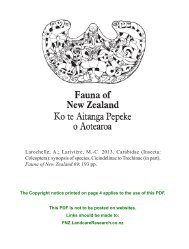Fauna of NZ 45 - Landcare Research
Fauna of NZ 45 - Landcare Research
Fauna of NZ 45 - Landcare Research
Create successful ePaper yourself
Turn your PDF publications into a flip-book with our unique Google optimized e-Paper software.
<strong>Fauna</strong> <strong>of</strong> New Zealand <strong>45</strong> 33<br />
(5) fore legs with a broad, densely hairy grooming device<br />
between outer tooth and spur instead <strong>of</strong> a long comb leading<br />
away from the spur on the lower edge <strong>of</strong> tibiae;<br />
(6) claws with one or more setae instead <strong>of</strong> none in any<br />
other brentines; and<br />
(7) by females in having four intersegmental glandular<br />
pouches instead <strong>of</strong> two or none.<br />
Because the first six characters are presumed ancestral<br />
(plesiomorphic) elsewhere in weevils, Lasiorhynchus will<br />
undoubtedly deserve a special consideration in any<br />
phylogenetic analysis <strong>of</strong> the genera <strong>of</strong> the subfamily.<br />
Schoenfeldt (1908) and Kleine (1938) have placed the<br />
Sulawesian Prodector Pascoe (1862) alongside<br />
Lasiorhynchus thus presumably implying affinity with it.<br />
The description <strong>of</strong> Lasiorhynchus above takes this into<br />
account by attending to morphological areas <strong>of</strong> interest<br />
separating these genera.<br />
The principal distinguishing features <strong>of</strong> Prodector in<br />
regard to Lasiorhynchus are:<br />
(1) the base <strong>of</strong> head has an abruptly cut-<strong>of</strong>f neck;<br />
(2) the gular suture is very short;<br />
(3) the tentorium pit is near the base by the neck;<br />
(4) the beard hairs <strong>of</strong> the male rostrum are directed<br />
apicad;<br />
(5) the scutellum is concealed;<br />
(6) the elytral base vertical;<br />
(7) the shoulders have a tooth between side and base;<br />
(8) the inferolateral flange <strong>of</strong> the elytra is continued by<br />
an oblique flange to suture;<br />
(9) the fore tibiae are glabrous and shiny between the<br />
outer tooth and the spurs and have a long comb <strong>of</strong> stiff<br />
setae leading away from the spurs;<br />
(10) the spur formula is 2-2-2;<br />
(11) the onychium has an advancing ventral lobe visible<br />
between the claws in dorsal view;<br />
(12) the claws have no setae;<br />
(13) the arms <strong>of</strong> the male sternite 9 are narrow;<br />
(14) the basal armature <strong>of</strong> the internal sac is bulky with<br />
diverse pigmentation consisting <strong>of</strong> a ring at base which has<br />
a median tubule for the ejaculatory duct to go through and<br />
continue pigmented to the end <strong>of</strong> the 0.7 mm long basal<br />
sclerite;<br />
(15) the female tergite 8 has nine teeth and the apex <strong>of</strong><br />
sternite 8 lacks fine denticulation;<br />
(16) the genital sheath lacks a sclerite near the base <strong>of</strong><br />
hemisternites;<br />
(17) the bursa is ventrally concave and apically bilobed;<br />
(18) the spermathecal gland is unpigmented.<br />
Etymology. Lasiorhynchus (‘densely hairy rostrum’) is a<br />
Greek compound, from lásios = densely hairy, and rhynchos<br />
= proboscis for weevil; gender masculine.<br />
Lasiorhynchus barbicornis (Fabricius)<br />
giraffe weevil, pepeke nguturoa<br />
Fig. 8, 9, 57, 100–109; Map 11<br />
Fabricius, 1775: 134 (Curculio); 1781: 171 (Curculio); 1787:<br />
95 (Brentus); 1792: 491 (Brentus); 1801: 5<strong>45</strong> (Brentus).<br />
—Gmelin, 1790: 1739 (Brentus). —Olivier, 1790: 190<br />
(Brentus); 1807: 432, pl. (84) 1:5, 2:5 (Brentus). —<br />
Herbst, 1797: 187, pl. 107: 7 (Brentus). —Latreille, 1797:<br />
(18) pl. 236: 1 (Brentus); 1828: 593 (Nemocephalus).<br />
—Schoenherr, 1833: 353 (Brenthus); 1840: 578<br />
(Brenthus). —Boisduval, 1835: 317 (Brenthus). —White,<br />
1846: 13 (Brentus; syn. assimilis). —Lacordaire, 1866:<br />
469. —Broun, 1880: 544; 1881: 228 (larva, pupa, biol.).<br />
—Sharp, 1899: 297 (biol.). —Schoenfeldt, 1908: 76, pl.<br />
2:5. —Kleine, 1920: 73 (‘strid. organ’). —Tillyard, 1926:<br />
240, pl. 19: 14. —Hudson, 1934: 122, pl. (adult, larva).<br />
—Kuschel, 1970: 194. —Meads, 1976: 171, fig. 1–5<br />
(biol.)<br />
assimilis Fabricius, 1775: 134 (Curculio); 1781: 171<br />
(Curculio); 1787: 95 (Brentus); 1792: 491 (Brentus);<br />
1801: 546. —Gmelin, 1790: 1739 (Brentus). —Olivier,<br />
1790: 190 (Brentus); 1807: 433, pl. (84) 2:6 (Brentus).<br />
—Herbst, 1797: 188, pl. 107: 8 (Brentus). —Schoenherr,<br />
1826: 69 (Brenthus); 1833: 356 (Brenthus). —Latreille,<br />
1828: 593 (Nemocephalus). —Boisduval, 1835: 317<br />
(Brenthus). —Gyllenhal, 1840: 565 (Teramocerus).<br />
Dull dark brown, elytra usually with three yellowish or<br />
reddish marks each, a humeral mark, a median mark, and a<br />
postmedian mark, sometimes with additional smaller markings.<br />
Vestiture consisting <strong>of</strong> sparse white or yellowish<br />
piliform or lineal scales, those on underside longer and<br />
broader; male with rather dense black, backward directed<br />
beard on underside <strong>of</strong> rostrum (Fig. 8).<br />
Rostrum in male 2.1–3.3x longer than prothorax;<br />
prorostrum short, strongly widening apicad, relatively shiny<br />
at apex, shallowly depressed lengthwise; postrostrum 6–<br />
14x longer than prorostrum (higher ratios corresponding to<br />
larger specimens), entirely dull, shallowly, indistinctly<br />
punctate dorsally, transversely convex above, sides vertical,<br />
lower edge <strong>of</strong> sides weakly or distinctly tuberculate on<br />
basal half. Rostrum in female 1.5x longer than prothorax;<br />
prorostrum shiny, 2.1x longer than postrostrum, finely,<br />
sparsely punctate, more coarsely punctate on sides near<br />
base, lacking scales, with sparse hairs instead; postrostrum<br />
dull, cylindrical, with lineal scales.<br />
Prothorax in male 2.0–2.6x longer than wide, with<br />
median groove, subcylindrical, mostly gently converging<br />
apicad; in female 1.6–1.8x longer than wide, elliptical, widest<br />
near middle, with groove from base to middle or slightly
















